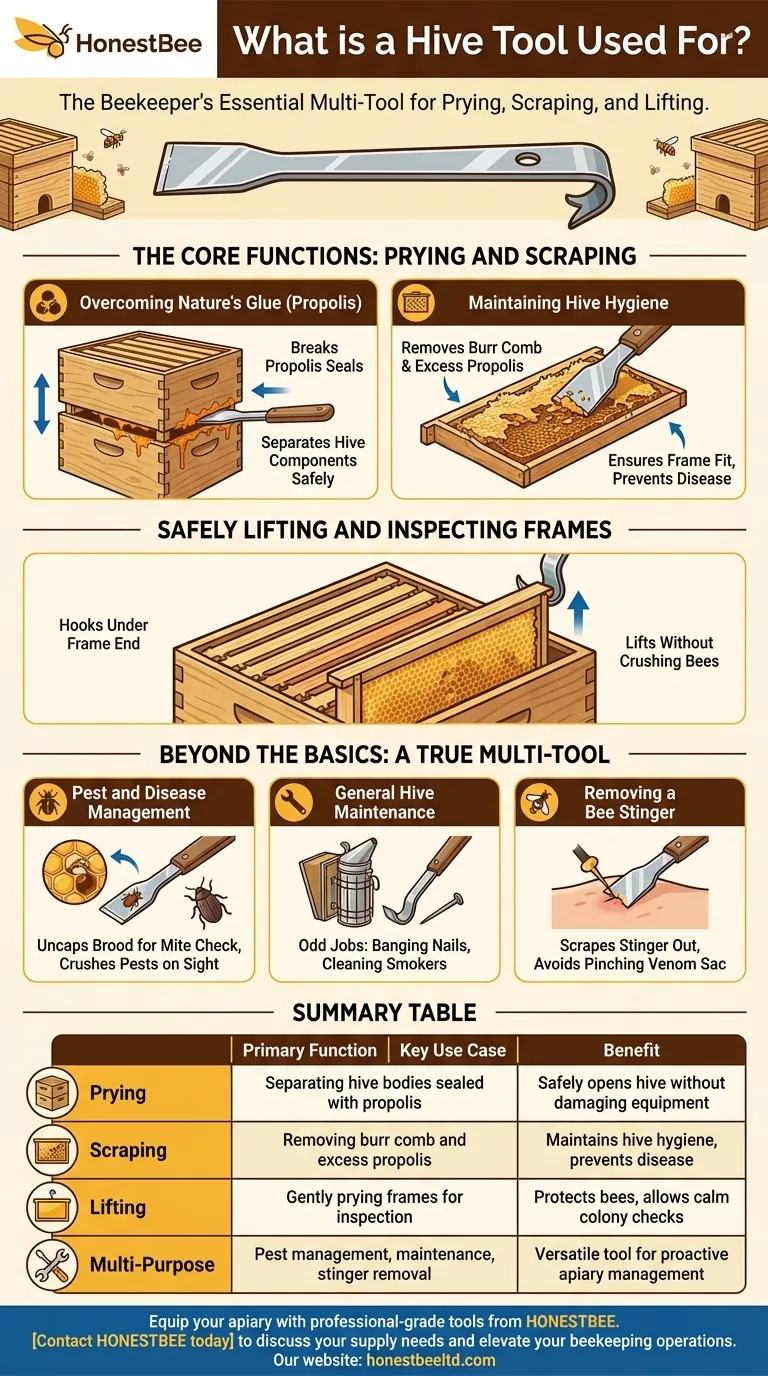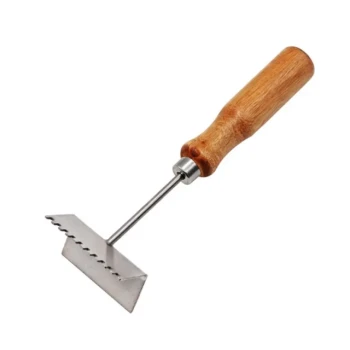A hive tool is the beekeeper's essential multi-tool, designed for the core tasks of prying, scraping, and lifting within a beehive. Its simple design allows a beekeeper to overcome the powerful propolis (bee glue) that seals a hive shut, manipulate frames for inspection, and perform critical hive maintenance without damaging the equipment or harming the colony.
The central challenge in beekeeping is interacting with a structure that bees have meticulously glued together. The hive tool is the purpose-built solution, providing the leverage to safely separate components and the sharp edge to clean and maintain the hive's interior.

The Core Functions: Prying and Scraping
A beehive is not a set of loose wooden boxes; it is a single, unified structure sealed from the inside by the bees. Your ability to inspect and manage it depends entirely on the hive tool.
Overcoming Nature's Glue
Bees use a resinous mixture called propolis to seal every crack and seam in their hive. This makes the hive watertight and draft-proof, but it also glues hive bodies, inner covers, and frames firmly together.
The primary job of the hive tool is to act as a miniature crowbar, allowing you to break these propolis seals and separate hive components with controlled force, preventing damage to the wooden boxes.
Maintaining Hive Hygiene
The sharp, beveled edge of the hive tool is a highly effective scraper. Beekeepers use it constantly to remove unwanted burr comb—wax built in undesirable places—and excess propolis from frames and hive bodies.
This regular cleaning is critical for hive health, as it ensures frames fit properly and removes debris that could harbor pests or disease.
Safely Lifting and Inspecting Frames
Frames inside a hive box fit tightly and are often glued in place with both wax and propolis. The curved or "J" hook end of a standard hive tool is specifically designed to hook under the end of a frame.
This provides the leverage to gently lift the frame straight up without rolling or crushing bees, which is essential for a calm and effective hive inspection.
Beyond the Basics: A True Multi-Tool
The hive tool's versatility extends far beyond its primary functions, making it the one tool a beekeeper always has on hand.
Pest and Disease Management
The tool is instrumental in proactive colony health checks. Beekeepers use it to uncap drone or worker brood to inspect for varroa mites, a devastating parasite.
It's also commonly used to crush pests like the Small Hive Beetle on sight, directly protecting the colony during an inspection.
General Hive Maintenance
The hive tool's robust metal construction makes it a go-to for various odd jobs around the apiary. It's used for banging in a loose nail, opening a can of paint, or even cleaning out a jammed smoker.
Removing a Bee Stinger
When stung, the sharp edge of a hive tool is perfect for scraping the stinger out of the skin. Scraping is crucial because pinching a stinger with fingers or tweezers can inject more venom from the attached venom sac.
Understanding the Trade-offs: Why Not Just Use a Screwdriver?
While a screwdriver might seem like a viable substitute, using one is a common and costly mistake for new beekeepers.
The High Risk of Damage
A screwdriver concentrates prying force onto a small point, which can easily splinter, dent, and damage the soft wood of hive bodies and frames. A proper hive tool has a wider, flatter blade that distributes this force, protecting your equipment.
Not Designed for the Task
A standard hive tool is purpose-built. The long, flat end provides optimal leverage for separating boxes, while the curved end is perfectly shaped for lifting frames. No other single tool combines these functions as effectively or safely.
Applying the Tool to Your Goal
How you use the tool depends entirely on the immediate task at hand.
- If your primary focus is separating hive bodies: Insert the long, flat end into the seam between boxes and use it as a lever, gently working your way around the hive.
- If your primary focus is lifting a frame for inspection: Use the curved or "J" hook end to hook under the frame's tab and gently pry it straight upwards.
- If your primary focus is cleaning hive components: Use the sharp, beveled edge like a putty knife to scrape away any unwanted propolis or burr comb.
Mastering this simple tool is the first step toward becoming a confident, effective, and gentle beekeeper.
Summary Table:
| Primary Function | Key Use Case | Benefit |
|---|---|---|
| Prying | Separating hive bodies sealed with propolis | Safely opens the hive without damaging equipment |
| Scraping | Removing burr comb and excess propolis | Maintains hive hygiene and prevents disease |
| Lifting | Gently prying frames for inspection | Protects bees and allows for calm colony checks |
| Multi-Purpose | Pest management, maintenance, stinger removal | Versatile tool for proactive apiary management |
Equip your apiary with professional-grade tools from HONESTBEE.
As a trusted supplier for commercial apiaries and beekeeping equipment distributors, we provide the durable, purpose-built hive tools and equipment you need to work efficiently and protect your investment. Our wholesale-focused operations ensure you get reliable gear that stands up to daily use.
Contact HONESTBEE today to discuss your supply needs and elevate your beekeeping operations.
Visual Guide

Related Products
- HONESTBEE Advanced Ergonomic Stainless Steel Hive Tool for Beekeeping
- Professional Dual-End Stainless Steel Hive Tool for Beekeeping
- Professional Stainless Steel J-Hook Hive Tool
- Professional Wide Blade Honey Scraper for Beekeeping and Honey Processing
- Professional Stainless Steel Frame Cleaner with Ergonomic Wood Handle
People Also Ask
- What tools are used for cleaning frames? A Beekeeper's Simple 4-Tool Guide
- What is a hive tool and what are its uses? Master Your Hive Inspections with the Essential Beekeeper's Tool
- Why is it important to compare the progress of different hives? A Beekeeper's Key Diagnostic Tool
- How is a hive tool used for scraping and cleaning? Master Hive Maintenance for a Healthy Colony
- Why do hive tools have a hole? Unlock the Secret to Efficient Beekeeping



















